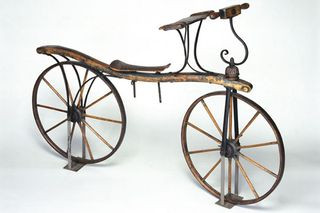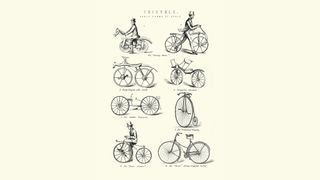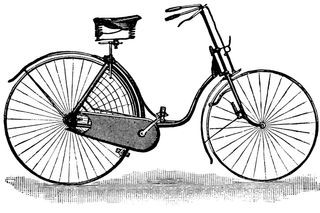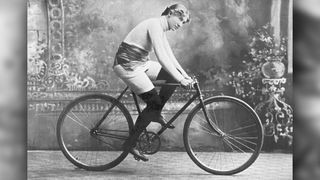The question of who invented the first bike is complex, but usabikers.net is here to unravel the intriguing history of cycling! While the modern bicycle has evolved significantly, the earliest iterations of human-powered, wheeled vehicles laid the foundation for this incredibly popular mode of transportation and recreation. Keep reading to delve into the inventors, designs, and cultural shifts that shaped the evolution of the bicycle, also known as a cycle, wheel machine, or two-wheeler.
1. What Were The Earliest Precursors to the Bike?
The earliest precursors to the bike were human-powered vehicles designed centuries before the bicycle as we know it. These early inventions, like Giovanni Fontana’s four-wheeled device from 1418 and Karl von Drais’s “Laufmaschine” (running machine) in the early 19th century, represented the initial attempts to create a practical means of personal transportation.
1.1 Giovanni Fontana’s Four-Wheeled Device
In 1418, Italian engineer Giovanni Fontana created a human-powered vehicle featuring four wheels and a rope-and-gear system, according to the International Bicycle Fund (IBF). This early design represents one of the first known attempts to harness human power for wheeled transportation.
1.2 Karl Von Drais and the Laufmaschine
About 400 years after Fontana, Karl von Drais, a German aristocrat and inventor, developed his own version of a human-powered vehicle called the “Laufmaschine” (running machine). In 1817, Drais debuted a two-wheeled version, known as the Draisienne, dandy horse, or hobby horse, across Europe, marking a significant step toward the modern bicycle.
Drais’s invention was spurred by a serious crisis: a shortage of horses. The 1815 eruption of Mount Tambora in Indonesia caused a global ash cloud, lowering temperatures and leading to crop failures and the death of many animals, including horses, according to Smithsonian Magazine. The Laufmaschine offered a horse-less mode of transportation during this challenging time.
2. How Did the “Hobby Horse” Influence Early Bike Design?
The “hobby horse,” or Draisienne, significantly influenced early bike design by introducing the two-wheeled concept and popularizing personal mobility, though it differed greatly from today’s bicycles. Weighing about 50 pounds (23 kilograms), this early bicycle featured a wooden frame, two wooden wheels, a leather saddle, and wooden handlebars. Riders propelled the device forward by pushing off the ground with their feet.
2.1 The Hobby Horse Fad and Its Decline
Drais introduced his invention in France and England, where it gained popularity. Denis Johnson, a British coach maker, marketed his own version, called “pedestrian curricles,” to London’s upper class. However, the hobby horse fad faded by the 1820s, as these vehicles were banned from sidewalks due to safety concerns, according to the National Museum of American History (NMAH).
 Baron Karl von Drais in France is credited with inventing the
Baron Karl von Drais in France is credited with inventing the
Baron Karl von Drais is credited with inventing the Dandy Horse in 1817.
3. What Were “Bone Shakers” and Penny-Farthings?
“Bone shakers” and penny-farthings were subsequent iterations in bicycle design that emerged in the mid-19th century. “Bone shakers,” or velocipedes, featured steel wheels, pedals, and a fixed gear system. Penny-farthings were known for their large front wheels, designed to increase speed with each pedal rotation, offering a smoother ride due to solid rubber tires and long spokes.
3.1 The Murky Origins of the Velocipede
The precise inventor of the velocipede remains uncertain. Karl Kech claimed to have attached pedals to a hobby horse in 1862, but the first patent for a two-wheeled vehicle with crank pedals was granted to Pierre Lallement, a French carriage-maker, in the United States in 1866, according to the NMAH.
3.2 Michaux and the Olivier Brothers
In 1864, Pierre Lallement exhibited his invention, which inspired Aime and Rene Olivier, along with their classmate Georges de la Bouglise, to create their own velocipede. They enlisted Pierre Michaux, a blacksmith and carriage maker, to produce the parts needed for their invention. By 1867, Michaux and the Olivier brothers were marketing their velocipede with pedals, achieving considerable success. Despite disagreements that led to the dissolution of their initial partnership, the Olivier-owned Compagnie Parisienne continued to thrive.
3.3 The Penny-Farthing Craze
By 1870, cyclists sought improvements over the “bone shaker” design, and advancements in metallurgy allowed for stronger and lighter metal frames, according to the IBF. The high wheeler, or penny-farthing, gained popularity due to its larger front wheel, which allowed riders to travel farther with each pedal rotation. However, the design was not practical for most riders, as sudden stops could easily throw the rider over the front wheel, giving rise to the term “taking a header.”
 A 19th-century engraving shows early types of cycles, including the Dandy-Horse, the Dublin Velocipede and the Bone-shaker.
A 19th-century engraving shows early types of cycles, including the Dandy-Horse, the Dublin Velocipede and the Bone-shaker.
A 19th-century engraving showing early cycles.
4. How Did the “Safety Bicycle” Revolutionize Bike Design?
The “safety bicycle,” invented by John Kemp Starley in the 1870s, revolutionized bike design by prioritizing stability and practicality, making cycling accessible to a wider audience. Starley’s “Rover,” introduced in 1885, featured nearly equal-sized wheels, center pivot steering, and a chain drive, setting the standard for modern bicycle design.
4.1 Starley’s Early Innovations
Starley began marketing his bicycles in 1871, introducing the “Ariel” bicycle in Britain, solidifying the nation’s leadership in bicycle innovation for decades. He is also credited with inventing the tangent-spoke wheel in 1874, which significantly improved ride comfort and reduced the weight of bicycles.
4.2 The “Rover” and Its Impact
The “Rover,” introduced in 1885, was a pivotal design that included nearly equal-sized wheels, center pivot steering, and differential gears with a chain drive. This design made the bicycle more stable and practical, leading to a surge in bicycle use from an estimated 200,000 in 1889 to 1 million in 1899, according to the NMAH.
5. What Was the Bicycle’s Impact on Society?
The bicycle had a profound impact on society, democratizing transportation, influencing fashion, and driving improvements in road infrastructure. It also paved the way for the development of the automobile.
5.1 Bicycles and Social Change
Originally an expensive hobby, mass production made bicycles affordable for the working class, providing independent transportation to and from work. As women began cycling in large numbers, fashion evolved to accommodate the activity, with bloomers replacing bustles and corsets.
5.2 Infrastructure Improvements
The growing popularity of bicycles led to demands for better road conditions. Cyclists and railroad companies collaborated to improve roads, facilitating connections between farmers, businesses, and rail stations, according to the NMAH.
5.3 The Bicycle’s Influence on the Automobile
The bicycle directly influenced the introduction of the automobile. Bicycle parts, such as ball bearings, differential units, steel tubing, and pneumatic tires, were incorporated into early automobile designs. Many pioneer automobile builders, including Charles Duryea, Alexander Winton, and Albert A. Pope, were initially bicycle manufacturers. Even aviation pioneers like Wilbur and Orville Wright and Glenn Curtiss started as bicycle makers.
 A ladies
A ladies
An 1889 ladies’ safety bicycle.
5.4 Decline and Resurgence
As automobiles gained popularity, interest in bicycles declined in the early 1900s. Electric railways also took over bicycle paths, leading to a decrease in bicycle manufacturers. However, adult interest in cycling reemerged in the late 1960s as people sought non-polluting modes of transportation and recreation. By 1970, the United States manufactured nearly 5 million bicycles, and an estimated 75 million riders shared 50 million bicycles, making cycling the nation’s leading outdoor recreation, according to the NMAH.
6. What Is the State of Bicycles Today?
Today, over 100 million bicycles are manufactured each year, and an estimated 1 billion bicycles are in use worldwide, according to Bicycle History. The market offers a wide range of bicycle designs and materials tailored to various riding conditions.
6.1 Modern Bicycle Designs
Modern bicycles feature frames made from materials like steel, aluminum, titanium, carbon fiber, and even bamboo, according to Bike Bamboo. Wheels come in various sizes and thicknesses for different surfaces, from rough mountain roads to smooth city streets. Riders can choose from different types of brakes, gear systems, seat shapes, handlebar positions, and suspension options.
6.2 Innovations and Variations
Bicycles today can have anywhere from one to 33 gears, with specialized seats for racing or comfortable rides. Suspension systems enhance comfort on bumpy paths. Innovative designs include foldable bicycles, bikes resembling elliptical machines, bikes with attached strollers, and even electric-powered bicycles.
 Racing cyclist Tillie Anderson sitting on her bike. in 1896, the League of American Wheelmen recognized her as the best woman cyclist in the world.
Racing cyclist Tillie Anderson sitting on her bike. in 1896, the League of American Wheelmen recognized her as the best woman cyclist in the world.
Racing cyclist Tillie Anderson in 1896.
7. Why Is Motorcycle Safety Crucial for Bikers?
Motorcycle safety is crucial for bikers due to the inherent risks of riding and the potential for serious injury. According to research from the Motorcycle Safety Foundation (MSF) in July 2025, investing in proper training and safety gear significantly reduces the risk of accidents and injuries.
7.1 Essential Safety Measures
Riders can improve their safety by wearing helmets, protective clothing, and understanding motorcycle-specific traffic laws. The Motorcycle Safety Foundation (MSF) offers courses and resources to enhance rider skills and promote safe riding habits.
7.2 The Role of Rider Education
Comprehensive rider education programs equip motorcyclists with the knowledge and skills necessary to navigate traffic safely. These programs cover topics such as defensive riding techniques, hazard awareness, and proper motorcycle maintenance.
8. What Are Some Popular Motorcycle Events and Rallies in the USA?
The USA hosts numerous popular motorcycle events and rallies, offering riders opportunities to connect, share their passion, and experience the camaraderie of the biker community. Events like the Sturgis Motorcycle Rally in South Dakota and Daytona Bike Week in Florida attract thousands of motorcycle enthusiasts each year.
8.1 Sturgis Motorcycle Rally
The Sturgis Motorcycle Rally, held annually in Sturgis, South Dakota, is one of the largest and most famous motorcycle rallies in the world. The event features bike shows, races, concerts, and scenic rides through the Black Hills.
8.2 Daytona Bike Week
Daytona Bike Week in Daytona Beach, Florida, is another major motorcycle event that draws large crowds. The event includes races, bike shows, concerts, and various vendors catering to motorcycle enthusiasts.
8.3 Other Notable Events
Other notable motorcycle events in the USA include the Laconia Motorcycle Week in New Hampshire, the Americade in Lake George, New York, and the Republic of Texas Biker Rally in Austin, Texas. These events offer a mix of entertainment, riding opportunities, and community engagement.
| Event | Location | Time of Year |
|---|---|---|
| Sturgis Motorcycle Rally | Sturgis, SD | August |
| Daytona Bike Week | Daytona Beach, FL | March |
| Laconia Motorcycle Week | Laconia, NH | June |
| Americade | Lake George, NY | June |
| Republic of Texas Biker Rally | Austin, TX | June |
9. How Can Bikers Stay Updated on Motorcycle Laws and Regulations?
Staying updated on motorcycle laws and regulations is essential for bikers to ensure compliance and safety. Laws vary by state, covering aspects such as helmet requirements, lane splitting, and equipment standards.
9.1 State Motorcycle Laws
Each state has its own set of laws and regulations governing motorcycle operation. Riders should familiarize themselves with the specific laws in the states where they ride.
9.2 Resources for Staying Informed
Bikers can stay informed by consulting official state government websites, motorcycle advocacy groups like the American Motorcyclist Association (AMA), and online forums. Websites like usabikers.net provide updated information on motorcycle laws and regulations across the USA.
10. Where Can Bikers Find a Strong Community and Reliable Information?
Bikers can find a strong community and reliable information on websites like usabikers.net, which offers a platform for connecting with other motorcycle enthusiasts, accessing valuable resources, and staying informed about the latest trends and events.
10.1 The Role of Online Communities
Online communities play a vital role in connecting bikers, providing a space for sharing experiences, asking questions, and offering support. These communities often feature forums, blogs, and social media groups where riders can engage with each other.
10.2 Benefits of Joining Usabikers.net
Usabikers.net offers a comprehensive resource for bikers, including articles, reviews, event listings, and a forum for community discussions. By joining usabikers.net, riders can access a wealth of information and connect with a passionate community of fellow enthusiasts.
10.3 Additional Resources for Bikers
In addition to online communities, bikers can find valuable information from motorcycle magazines, books, and local motorcycle clubs. These resources provide insights into motorcycle maintenance, riding techniques, and the latest industry news.
The journey of the bicycle from its humble beginnings to its modern form is a testament to human ingenuity and the enduring appeal of personal mobility. Whether you’re a seasoned biker or new to the world of motorcycles, remember that safety, knowledge, and community are essential for enjoying the ride.
Ready to dive deeper into the world of motorcycles and connect with a vibrant community of fellow riders? Visit usabikers.net today to explore insightful articles, connect with other enthusiasts, and stay updated on the latest motorcycle news and events.
Address: 801 Sturgis Main St, Sturgis, SD 57785, United States.
Phone: +1 (605) 347-2000.
Website: usabikers.net.
FAQ About the Invention of the Bicycle
1. Who is widely credited with inventing an early form of the bicycle?
Karl von Drais is widely credited with inventing an early form of the bicycle, known as the Draisienne or hobby horse, in 1817. This two-wheeled, human-powered vehicle was a significant step toward the modern bicycle.
2. What was the Draisienne, and how did it work?
The Draisienne, invented by Karl von Drais, was a two-wheeled vehicle made of wood, without pedals. Riders propelled it by pushing off the ground with their feet, similar to running while seated.
3. Who invented the velocipede, also known as the “bone shaker”?
The exact inventor of the velocipede is debated, but Pierre Lallement received the first U.S. patent for a two-wheeled vehicle with crank pedals in 1866. The design was further popularized by Pierre Michaux and the Olivier brothers.
4. What made the penny-farthing bicycle unique?
The penny-farthing bicycle was unique due to its large front wheel and smaller rear wheel. The large front wheel allowed riders to travel farther with each pedal rotation, but it also made the bike unstable and difficult to ride.
5. Who invented the “safety bicycle,” and why was it significant?
John Kemp Starley invented the “safety bicycle” in the 1870s, with his “Rover” model in 1885 being the most influential. It featured equal-sized wheels, center pivot steering, and a chain drive, making it safer, more stable, and more practical than previous designs.
6. How did the invention of the bicycle impact society?
The invention of the bicycle had a significant impact on society by providing affordable transportation, influencing fashion, improving road conditions, and paving the way for the development of the automobile.
7. What materials are modern bicycle frames made of?
Modern bicycle frames are made of various materials, including steel, aluminum, titanium, carbon fiber, and even bamboo. Each material offers different properties in terms of weight, strength, and ride quality.
8. What are some popular motorcycle events in the USA?
Some popular motorcycle events in the USA include the Sturgis Motorcycle Rally in South Dakota, Daytona Bike Week in Florida, Laconia Motorcycle Week in New Hampshire, Americade in Lake George, New York, and the Republic of Texas Biker Rally in Austin, Texas.
9. How can bikers stay updated on motorcycle laws and regulations?
Bikers can stay updated on motorcycle laws and regulations by consulting official state government websites, motorcycle advocacy groups like the American Motorcyclist Association (AMA), and online forums such as usabikers.net.
10. Where can bikers find a strong community and reliable information?
Bikers can find a strong community and reliable information on websites like usabikers.net, which offers a platform for connecting with other motorcycle enthusiasts, accessing valuable resources, and staying informed about the latest trends and events.
